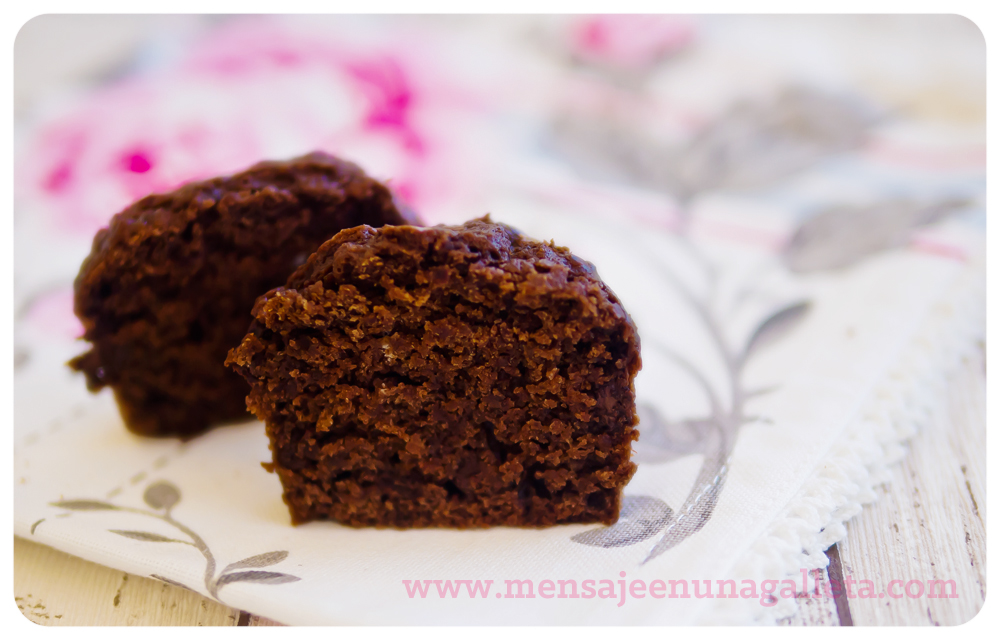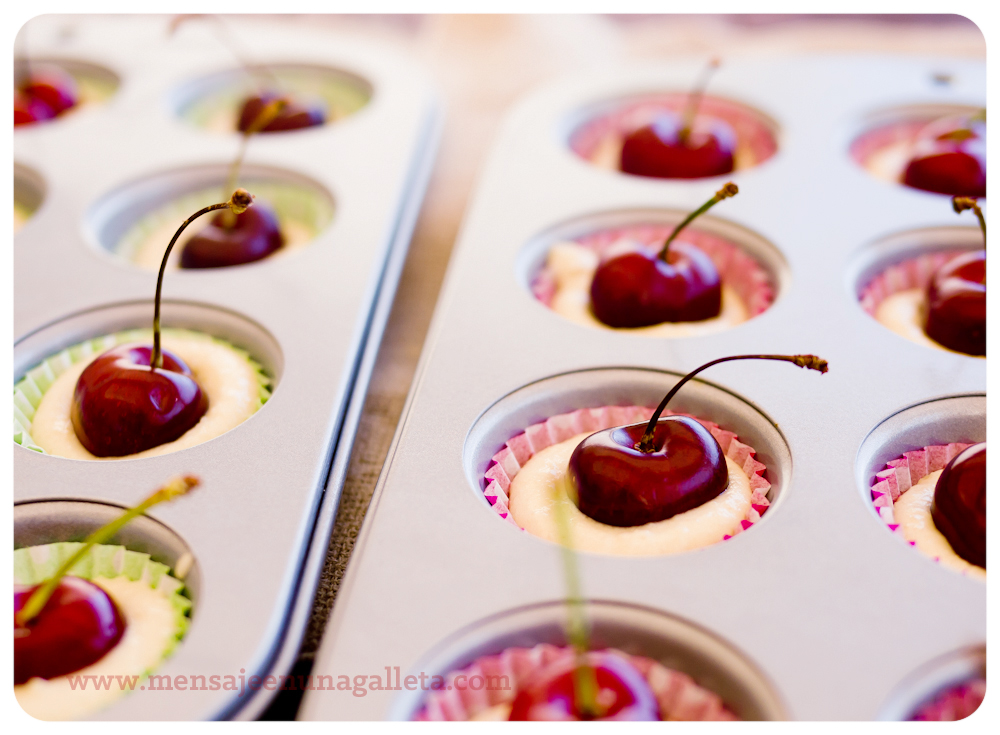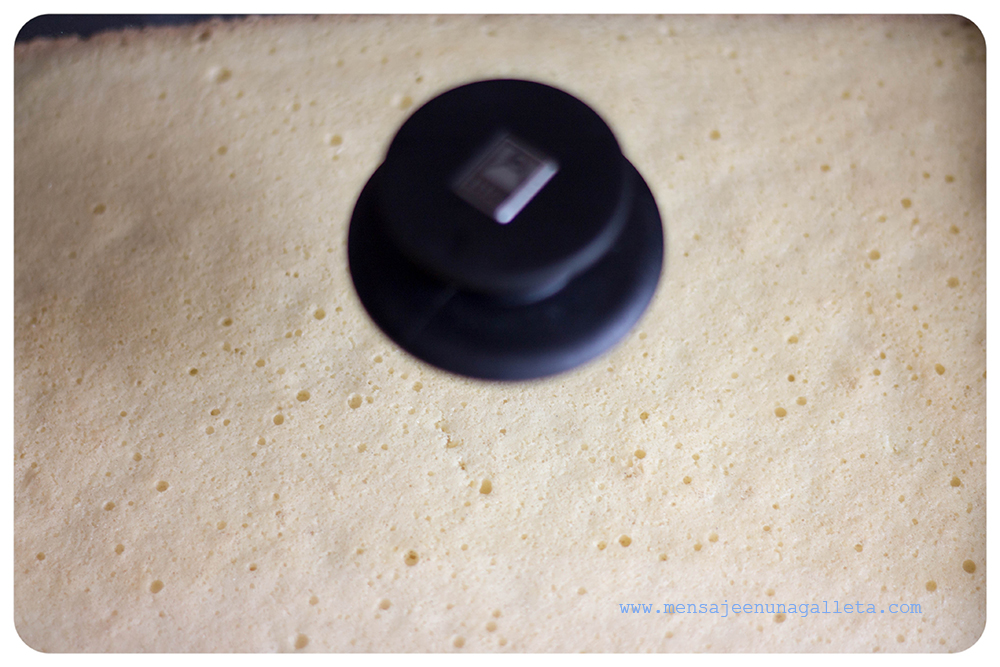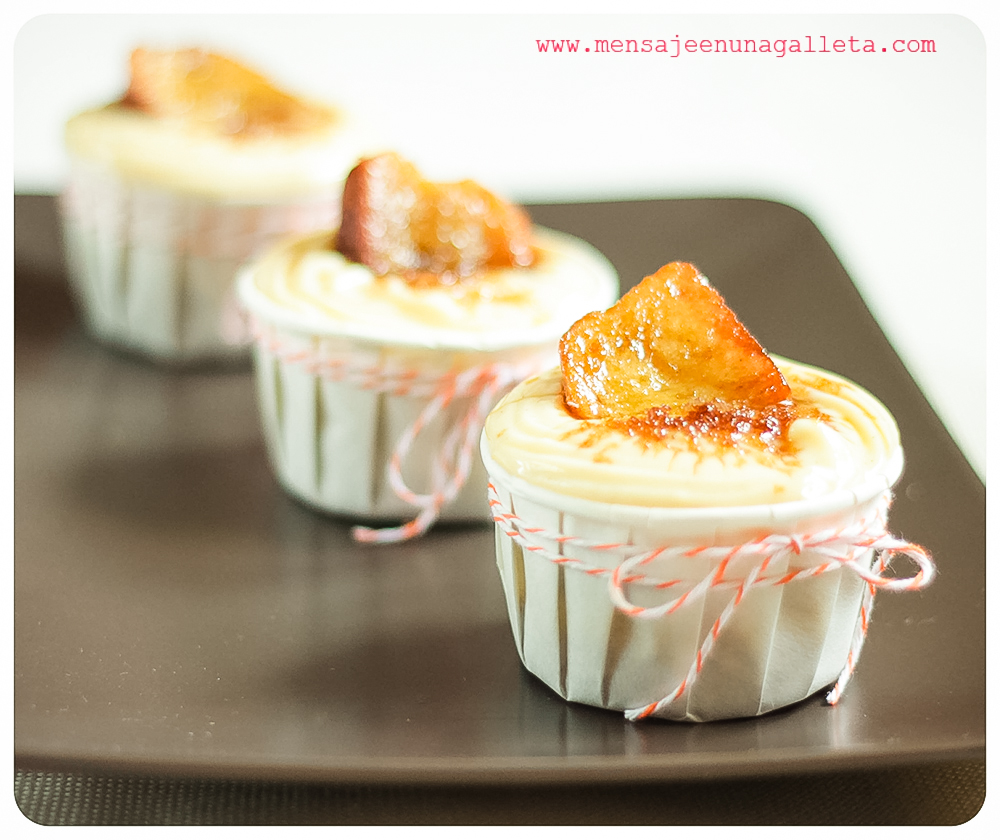
Cada vez que llega el Miércoles de Ceniza a los malagueños se nos enciende automáticamente el pilotito de «Cuaresma on». Esta época del año tiene una gastronomía rica y variada, como el arroz con leche,el potaje de vigilia, el bacalao con tomate o las torrijas. Si venís a Málaga no podéis dejar de probar las de La Canasta y las de la panadería La Leonesa, mis preferidas porque tienen unos toques de cítricos que son muy de Semana Santa y porque llevan crema, y las torrijas con crema pastelera me pirran.
Every Ash Wednesday people from Málaga automatically turn our ‘Lent pilot’ on. This time of the year has a rich and varied gastronomy: rice pudding, fast stew, cod with tomato or torrijas. If you come to Málaga you should not miss the torrijas from La Canasta and the ones from La Leonesa bakery, my favourites because they have a citric touch very typical from Easter and because they have cream, and torrijas with custard cream drive me crazy.
(If you’re wondering what a torrija is, it’s a typical dessert of Lent and Easter in Spain. It consists of a slice of bread that is soaked in milk or wine with honey and spices, and, after being dipped in egg, fried in a pan with olive oil).
¿Y cómo encajan unas torrijas en esto de la repostería creativa? ¡Pues en forma de cupcakes!. Ponéos cómodos porque aquí vais a poder ver toda la elaboración. Es entretenida pero fácil y, sobre todo, deliciosa, porque vais a disfrutar con los cinco sentidos.
And how do torrijas fit in this thing called creative pastry? Easy: like a cupcake! Make yourself comfy because here you will find the whole elaboration process. It is a bit time consuming but easy, and most of all, delicious, because you will enjoy it with your five senses.
La receta del pan (que prepararemos el día antes) es de tipo brioche, a la que he añadido unos toques de ralladura de piel de naranja y de limón, además de un poco de aroma de agua de azahar buscando un retrogusto (ya sueno a food blogger) cítrico y floral.
The bread recipe (which we will prepare the day before) is for a kind of brioche loaf adding some orange and lemon zest, and a few drops of orange blossom water aroma looking for a citric and floral retro taste (Gosh I sound like proper food blogger!)
Ahí van los ingredientes:
500 gr de harina de fuerza
4 huevos
90 gr de leche entera
30 gramos de levadura prensada fresca
60 gr de azúcar
5 gr de sal
100 gr de mantequilla
1/4 tsp de aroma de azahar (ojo, yo he usado uno concentrado)
1 tira de piel de naranja de 1 cm de ancho
1 tira de piel de limón, también de 1 cm de ancho
These are the ingredients:
500 grams of bread flour
4 eggs
90 grams of whole milk
30 grams of yeast
60 grams of sugar
100 grams of butter
¼ tsp orange blossom water aroma (careful! I used a concentrated one)
1 orange peel strip (1 cm. wide)
1 lemon peel strip (1 cm.wide)
Elaboración del pan/ Bread making
Echamos la leche en el vaso con las pieles de naranja y limón y mezclar a velocidad máxima durante 1 minuto. Después ponemos 30 segundos a velocidad 1 a 37 grados.
In the Thermomix bowl, putt he milk, orange and lemon peel strips and mix max speed for 1 minute. Then, 30 seconds, speed 1, 37 degrees.
Desmenuzamos la levadura en la leche y mezclamos durante 10 segundos a velocidad 1
Shred the yeast in the milk and mix for 10 seconds, speed 1.
Añadimos los huevos, la harina, el azúcar y la sal. Mezclar durante 30 segundos a velocidad 6. Amasamos 3 minutos a velocidad espiga.
Add the eggs, flour, sugar and salt. Mix for 30 seconds, speed 6. Knead for 3 minutes using the kneading button.
Durante 2 minutos, nuevamente a velocidad espiga, vamos añadiendo por el bocal la mantequilla cortada en cuadraditos.
During 2 more minutes at kneading speed again, we start adding the butter cut in small dices
Dejamos reposar la masa dentro del vaso una hora. Después bajamos la masa con la espátula y amasamos 1 minuto a velocidad espiga.
We let the dough sit for an hour in the bowl. Then, using the spatula, we scrap the sides of the bowl and use the kneading speed for 1 minute.
Esparcimos un poco de harina sobre la mesa de trabajo y ponemos la Thermomix bocabajo, le damos unas vueltas a la parte inferior de las cuchillas para hacer que la masa caiga. Ponemos el vaso en la Thermomix de nuevo y damos 3 ó 4 golpes de turbo para que la velocidad centrífuga haga que se desprendan los restos de masa que siguen pegados en el vaso.
Spread some flour on the kitchen top and turn the TMX upside down, then we make the inferior part of the blades spin so the dough falls. We start the TMX again and press 3 or 4 times the turbo button so the centrifugation speed makes any posible piece of dough fall.
Cortamos la masa en cuatro partes iguales y hacemos con ellas unas barras con más o menos gracia (no como yo). Hay que dejarlas reposar durante 45 minutos para que suban otra vez, colocamos entre ellas unas láminas de papel de aluminio para que no se peguen al crecer.
Cut the dough in 4 equal parts and give them a bar shape with a certain ‘grace’ (not as I did). We have to let them sit for 45 minutes so they rise again, placing a piece of foil between them in order to avoid them sticking to each other when rising.
Precalentamos el horno a 200 grados y, si no tenemos una bandeja de horno con tapa que nos ayude a mantener una cocción húmeda, colocamos un vaso de agua en la parte inferior del horno. Pintamos la superficie con huevo batido y las metemos en el horno durante 30 minutos.
Preheat the oven to 200 degrees, and if we do not have an oven tray with a lid which helps us keep a humid baking, we will place a glass with water in the bottom of the oven. We paint the surface of the bars with a beaten egg and bake for 30 minutes.

Ingredientes para la preparación de las torrijas.
1/2 l. de leche entera (en Málaga también se suele usar vino moscatel en vez de la leche)
1 ramita de canela
1 par de huevos
Aceite de oliva virgen extra
Ingredients for the elaboration of the torrijas:
½ liter of whole milk (here in Malaga muscatel wine is frequently used instead of milk)
1 cinnamon stick
2 eggs
Extra virgin olive oil
Preparación de las torrijas.
Hervimos el medio litro de leche con una ramita de canela y la dejamos enfriar. Mientras, cortamos el pan en rebanadas de 1 cms, las pasamos por la leche (vuelta y vuelta) y después por los huevos batidos. Las freímos en abundante aceite de oliva virgen extra hasta que se doren. Como lleva huevo, el aceite se llenará de impurezas, vamos filtrándolo de vez en cuando para que no se llenen las torrijas de «mijitas».
Elaboration of the torrijas.
We boil have a liter of milk with the cinnamon stick and let it cool down. In the meantime, we cut the bread in 1 cms thick slices, soak them in the milk and then in the beaten egg. We fry them in abundant extra virgin olive oil until they get a golden colour. As they have egg on them, the oil will get full of impurities, so we need to filter it every so often so our torrijas do not get all covered in ‘little things’.

Vamos poniendo las torrijas sobre papel de cocina para que vaya absorbiendo el aceite sobrante.
We will place the torrijas on kitchen paper to absorb the extra oil.
Venga, que ya queda poco. Ahora toca la crema pastelera.
C’mon, we are almost there! Now it’s time for the custard cream.
Ingredientes.
360 gr de leche entera
90 gr. de azúcar
4 yemas de huevo
30 gr, de Maizena
1 tsp de vainilla bourbon en pasta
Ingredients
360 grams of whole milk
90 grams of sugar
4 egg yolks
30 grams of corn flour
1 tsp bourbon vanilla paste
Mezclamos la leche con la Maizena durante 30 segundos a velocidad 4 y reservamos.
We mix the milk with the corn flour for 30 seconds, speed 4 and reserve.
Ponemos la mariposa y echamos las yemas con el azúcar y batimos durante 2 minutos y 30 segundos a velocidad 3,5 para airearlas.
Put he butterfly of the TMX in place and add the egg yolks and sugar and mix during 2 minutes and 30 seconds, speed 3,5 to air them.
Incorporamos la leche y la vainilla y programamos 7 minutos a velocidad 4 y temperatura 90º.
Incorporate the milk and vanilla and program 7 minutes, speed 4 and 90 degrees.
Vertemos en un recipiente y, mientras se enfría, removemos de vez en cuando para que no se forme una costra en la superficie. Cuando ya esté templada, cubrimos con un papel del film tocando la superficie y la metemos en la nevera hasta que esté fría por completo.
Pour everything in a bowl and while it is cooling down, we will stir it every once in a while so we do not get a crust on the surface. When it is temperate, we will cover it with cling film touching the surface and place it in the fridge until is completely cold.
Ya estamos acabando, de verdad, ahora viene lo fácil. Con un cortador de galletas redondo, metálico mejor, cortamos las rebanadas de torrijas del tamaño que tengan nuestras cápsulas de cupcakes. Procurad coger todo lo que podáis de la corteza del pan.
I promise we are about to finish! Now, the easy part begins. Using a round cookie cutter, better if it’s a metallic one, we will cut slices of torrijas of the size of our cupcake liners. Try to get all the bread crust that you can.

Y los vamos metiendo en las cápsulas, echando sobre cada capa una capa de granos de azúcar integral de caña.
And we start introducing them in the liners, adding on top of each slice, a layer of integral cane sugar.

Metemos la crema pastelera en una manga (ojo, poned un plástico film en la punta del adaptador de la boquilla y coloca la boquilla después, porque es probable que se salga la crema mientras rellenáis la manga) y echamos un poco de crema, espolvoreada con canela en polvo.
We put the cream custard in a piping bag (and watch out, put a bit of cling film on the tip of the coupler, then place the tip, as it is very probable that the cream comes out of the bag while we are filling it) and add a bit of cream sprinkled with cinnamon powder.

Ponemos otra torrija encima, volvemos a echar el azúcar y decoramos la parte superior del vasito con más crema. Decoramos con una mini torrija bañada en miel.
Put another torrija on top, add some sugar again and decorate the top of the cupcake liner with more cream and a mini torrija soaked in honey
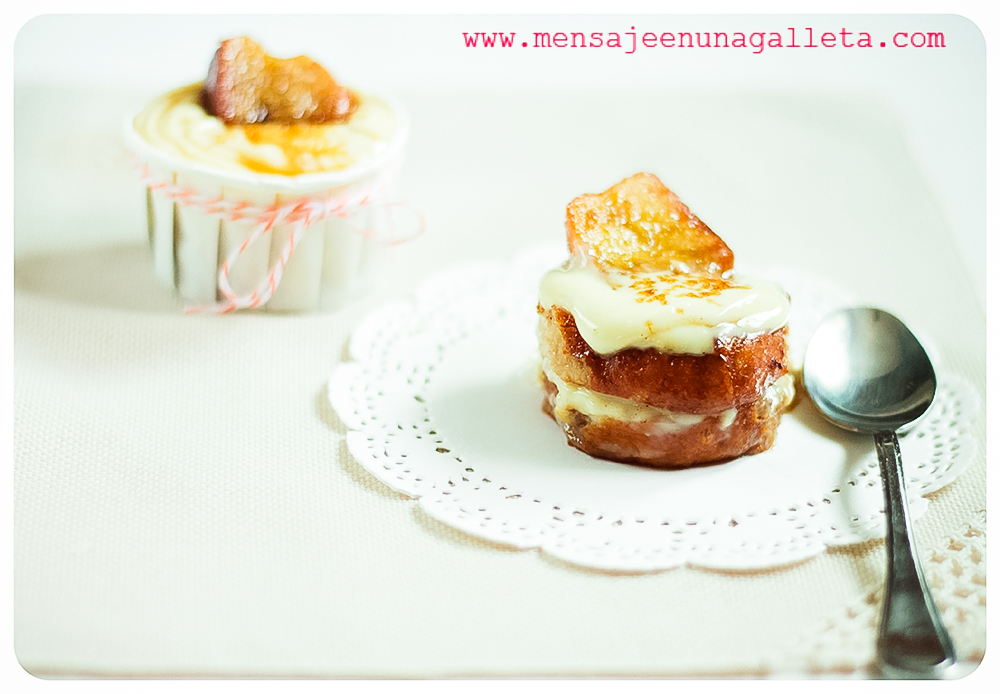

Un beso, Estíbaliz.
Love, Estíbaliz.
And even more love to Gloria.



